5 /10 1 Votes
6.2/10 TV No. of episodes 3,891 Running time 43 minutes | 3.8/10 IMDb Country of origin United States No. of seasons 25 Camera setup Multiple First episode date 30 September 1991 | |||||||||||||||||||||||||||||||||
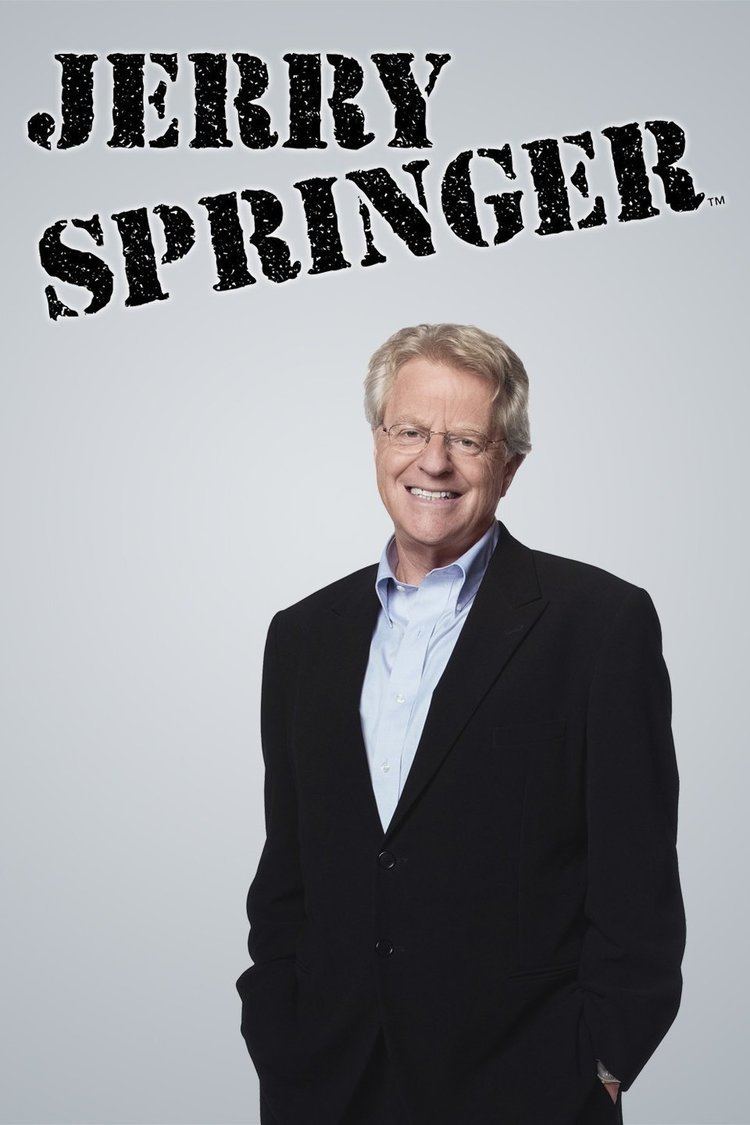 | ||||||||||||||||||||||||||||||||||
Similar Profiles | ||||||||||||||||||||||||||||||||||
The Jerry Springer Show (also known as Jerry Springer, or simply Springer) is an American syndicated Tabloid talk show hosted by Jerry Springer, a former politician. It is recorded at the Stamford Media Center in Stamford, Connecticut and is distributed by NBCUniversal Television Distribution.
Contents
- Online dating shocker the jerry springer show
- Format
- Set
- Security
- 1991
- 19921999
- Early 2000s
- Mid 2000s
- 2009 to present
- Controversies over authenticity and violence
- Censorship
- Too Hot for TV
- The Springer Show
- References
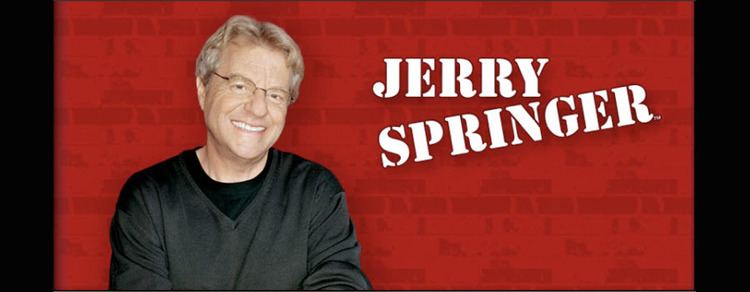
Online dating shocker the jerry springer show
Format

A typical episode of Springer begins with a title card warning parents that the show may contain content inappropriate for children. Springer then enters the stage by sliding down a stripper pole, being greeted by a standing audience (made up of mostly college students) pumping the air with their right hand, chanting "Jer-ry!, Jer-ry!". He then shakes hands with those in the front and, afterward, the audience settles down. Springer then welcomes viewers to the show, introduces a particular situation, or topic, and interviews several guests experiencing such situations. After finishing the interview, Springer announces the entrance of another guest whom the first guest would like to confront. The second guest enters the stage, and a confrontation between the two guests usually occurs, often breaking down into a brawl that is eventually broken up by on-set security personnel. Once the fight has been quelled, Springer interviews the second guest about the situation faced by the first guest. In many episodes, there is a third guest involved in the situation, who is also interviewed by Springer, and often takes part in the on-stage fighting. It is also not uncommon for a fourth guest to be involved. Often guests will be given a cup of water after fighting, ostensibly to "cool off," but inevitably, the guests toss the water at each other, thus resuming the altercation.
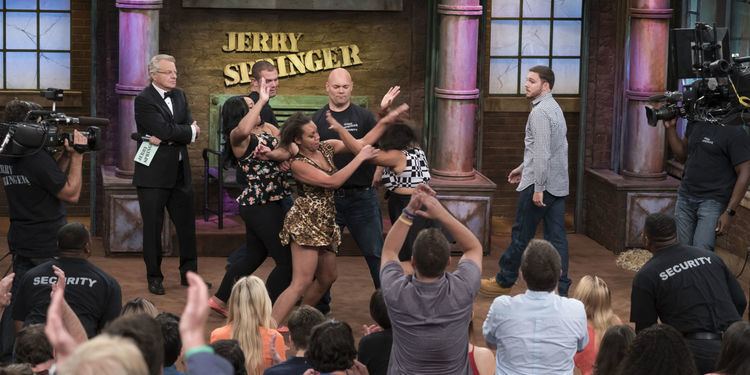
This cycle is repeated for each set of guests on the show. Once all guests have told their stories, there is usually a "question and answer" segment where audience members ask guests questions relevant to their situations, although usually the questions insult a guest or flash (show their breasts to) the audience in exchange for "Jerry Beads" (Mardi Gras-style beads with the show logo). Some adult audience members, however, may ask serious questions, which are mocked by the college-crowd audience to "Go to Oprah!". The producers then select the person with the most memorable question to say, "We'll be right back with Jerry's final thought." Springer then ends the show by giving a formal lecture, sitting by himself on the stage, on the principles of refined values in regards to the featured guests. He ends the segment with the concluding statement, "Till next time, take care of yourselves and each other," which was his sign-off line during his days as a newscaster in Cincinnati.
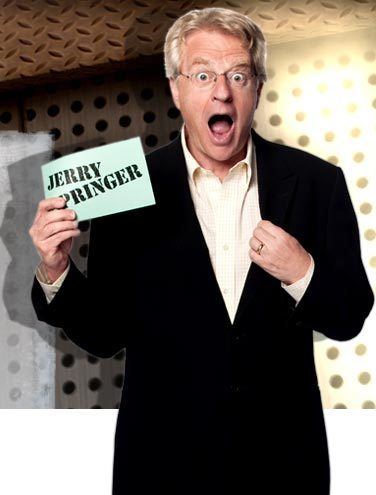
Generally, Springer tends to present his program standing up pacing the aisle steps between the seating areas rather than having a podium or mark on the main stage. This is thought to be to protect himself from the potential violence occurring on the stage.
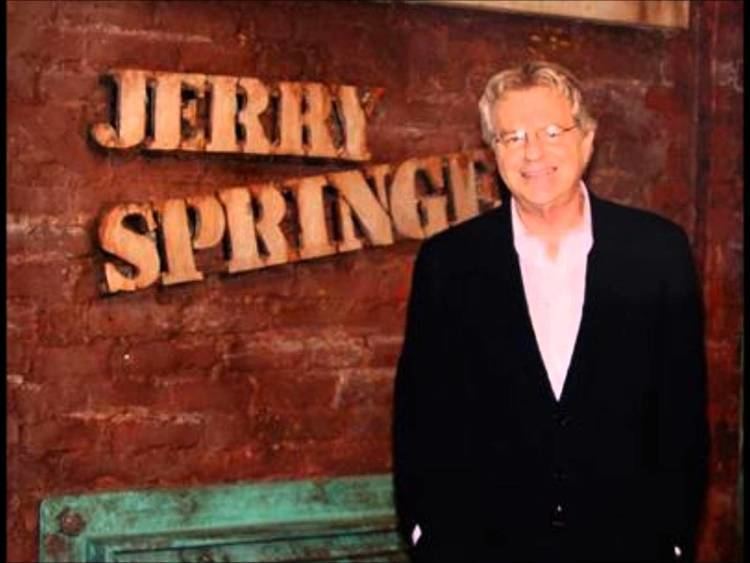
Sometimes the show will have a look back at previous episodes. These have been rebranded as Classic Springer, some with a false Masterpiece Theatre-like theme and patina. These shows are interspersed with commentary from Springer himself, usually before and after commercial breaks.
Set
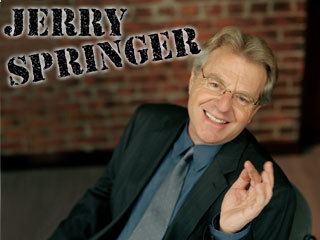
According to NBC, the set for the show has had two major changes over the years. When the show first started in 1991, it was very basic with white walls, in an effort to capture the feel of fellow talk show Donahue, Jerry's haircut and glasses even seeming to make him look like Phil Donahue. The general look of this set was carried over when the series first moved to Chicago in September 1992, with an unpolished, open air look and bright colored shapes.
In the fall of 1994, a few months after the series underwent its format overhaul, the studio received a makeover to make it look a bit warmer and more inviting, complete with brick walls, artwork, and bookcases. The stage walls were designed so that they could be projected outward into the audience, making room for a catwalk that was used in shows such as the 1998 episode Stripper Wars!. In late 2000 the whole set was changed again to its current "industrial" look, changes initially welcomed due to the reduced ratings of the 1999–2000 season. In 2007 the set was slightly changed, with a larger studio audience, bigger stage, and a balcony, which was above the stage and ended at the pole. Springer now uses this as his main entrance by sliding down the pole. The logo and stage design have been carried across to the new studio in Stamford, Connecticut with only a few changes.
Security
Steve Wilkos was the director of security from 1994–2007. He now hosts his own show, The Steve Wilkos Show, a spinoff of Springer. Pete Kelly was director of security from 2007–13. As of Season 23, the two primary security guards are long-time guard Jason Brandstetter and Dan Peterson.
1991
Jerry Springer debuted on September 30, 1991, with a family reunion as the topic of its first show. Initially, Springer was distributed by Multimedia Entertainment, later going to the former Universal and then to Studios USA.
Originally seen in only the four markets where Multimedia owned TV stations, it was dramatically different from today's version of the show. It started as an issues-oriented and political talk show, a longer version of the commentary for which Springer had gained local fame as a reporter and anchor, and for its first season, was even taped at Springer's former station, WLWT in Cincinnati. Guests early on included Oliver North and Jesse Jackson, and the topics included homelessness and gun politics, as well as the social effects of rock music, featuring shock rock star GG Allin, El Duce from The Mentors and GWAR as guests.
1992–1999
For its second season in the fall of 1992, the series was purchased by the NBC owned-and-operated stations, thus allowing it to finally achieve full national distribution, and production was moved to its longtime home at Chicago's NBC Tower (with Springer leaving his longtime position at WLWT in order to do so). However, ratings remained low, and after the first two seasons, original executive producer Burt Dubrow was ousted in favor of Terry Weible Murphy. By April 1994, Multimedia threatened cancellation if ratings didn't improve by that November, which led to a major overhaul that saw Murphy's departure and replacement by fellow Springer producer Richard Dominick.
The search for higher ratings led the program gradually towards provocative topics, becoming more successful as it became geared towards youthful viewers (modeled after Ricki Lake's popular talk show) by introducing more controversial topics. However, there were still some traditional and serious topics featured on the show at this time.
In December 1994, the show started featuring such topics as "My boyfriend turned out to be a girl" and "I want my man to stop watching porn!", as well as investigating which are sexier: bigger or smaller breasts on women.
In 1995, there were two performances by Comedy Central transgender star Jade Esteban Estrada. It became a "freak show" where guests seek their 15 minutes of fame through discussion and demonstrations of deviant behavior. In 1996, Springer wanted people to send him videotapes explaining why they wanted Springer to tape a show in their home. Its extraordinary success has led it to be broadcast in dozens of countries. The show gained so much popularity that for a while it was the top-rated daytime talk show in the United States.
In 1998, several stations that carried Springer, including WLWT in Cincinnati where Springer was a news anchor, refused to carry the episode "I Married A Horse", which led to it being pulled before airing.
In 1999, the show was parodied in the film Austin Powers: The Spy Who Shagged Me, with Dr. Evil and his son Scott discussing being evil. Along with Jerry, Steve Wilkos and Todd Schultz played themselves in the movie.
Early 2000s
In 2000, Springer was given a five-year, $30 million contract extension paying him $6 million per year. The same year, a married couple, Ralf and Eleanor Panitz, were guests on an episode of the show entitled "Secret Mistresses Confronted" with Mr. Panitz's ex-wife, Nancy Campbell-Panitz, in which they complained about Ms. Campbell-Panitz's behavior and accused her of stalking them. Hours after it was broadcast on July 24, 2000, Ms. Campbell-Panitz was found dead in a home that the three were fighting over, and Florida police soon confirmed that they were treating the death as a homicide. It was then reported that Mr. Panitz, having been issued a first-degree murder warrant for the death, was trying to flee to Canada to avoid prosecution. Upon news of the 52-year-old woman's murder, a spokeswoman for the program issued a statement saying that it was "a terrible tragedy."
In August 2000, Springer appeared on CNN's Larry King Live to discuss the incident, claiming that it "had nothing to do with the show" and that his talk show does not glamorize deviant behavior. On March 27, 2002, after a 10-day trial and 18 hours of deliberating from jurors, Mr. Panitz was convicted of the murder and sentenced to life in prison.
In 2001, efforts by groups like the Parents Television Council and the American Family Association forced some advertisers to decrease or to stop their sponsorship of Springer. In the United Kingdom, the Independent Television Commission banned Springer and other tabloid talk programs from being shown on television during daytime hours on school holidays in response to numerous parental complaints and concerns about children's potential exposure to the salacious content (there was a short-running British version of the show made for ITV called The Springer Show that was lighter and more tongue-in-cheek). The show also topped TV Guide magazine's 2002 list of "The Worst TV Shows Ever"; for a time, the show itself would even frequently boast about this ranking in its opening credits as a form of self-deprecation. The phrase "Jerry Springer Nation" began to be used by some who see the program as being a bad influence on the morality of the United States. In addition, the phrase has shown the association of Springer with any "lowbrow" type of entertainment in general.
In 2003, a British opera inspired by the series, Jerry Springer: The Opera, began playing in the United Kingdom. The same year, it was revealed that a group of guests from Hayward, California faked a "love triangle" for an appearance on two episodes of the show; one guest in the group was murdered, but Hayward police determined that his appearance was not connected to his murder.
By 2005, security director Steve Wilkos became sort of a cult figure on his own, and would close each show walking down a hallway engaging in casual talk with one of the more colorful guests of the preceding episode. He also would occasionally host the show. Episodes that he hosted were intended to be more serious in tone than the typical Springer show. Wilkos left Springer at the end of the 2006–2007 season to pursue his own talk show, The Steve Wilkos Show.
Mid-2000s
In 2005, the program became a subject of criticism in Bernard Goldberg's book 100 People Who Are Screwing Up America, being called "TV's lowest life-form" and Springer himself being ranked at 32 and labeled an "American Pioneer". Goldberg also claimed that Springer was knowingly capitalizing on the disadvantages of his guests and the stupidity of his audience, also citing the controversial episode revolving around the man who married his horse.
In January 2006, the show was renewed for its sixteenth season, ending speculation that Springer would leave his talk show to run for elected office in Ohio, where he is the former mayor of Cincinnati. By this time, the show began to poke fun at itself by using the taglines "An Hour of Your Life You'll Never Get Back" and "Wasting Technology Since 1991." On May 12, 2006, Springer celebrated his show's 3,000th episode by throwing a party on the show (which no one but Jerry showed up to humorously), and showed many clips, including rare excerpts from the show. 2006 also saw the addition of fan favorite, Reverend Shnorr, a drunken womanizing character who would often get into heated confrontations with guests all while bringing a fresh comedic edge to the show. The character was created by then Promotions Director Brian Schnoor while studying Improv at Chicago's famed Second City Theater in the 1990s. By December 2007, Rev Shnorr merchandise was out-selling the show's popular Security T-shirts on NBC's website.
In the United Kingdom, meanwhile, a Commercial High Court trial was scheduled for summer 2006 to resolve a dispute between Flextech Television and NBC Universal over Flextech in 2002 cancelling its 1998 contract to broadcast Springer in the UK as long as new episodes continued to be produced in the U.S.
In 2007, security director Wilkos left Jerry Springer to host his own syndicated talk show. The Steve Wilkos Show was also shot at the NBC Tower in Chicago and produced by Richard Dominick, who continued to produce Springer as well. On July 15, 2007, it was announced that Springer was picked up by NBC-Universal through the 2009–2010 season. Also, VH1 ran a documentary series The Springer Hustle, going "behind the scenes" of the show, having already run another Springer-related documentary in 2005 titled When Jerry Springer Ruled the World. Springer's appearance on the NBC television network show America's Got Talent led to an increase in viewership for the first quarter of 2007. Steve Wilkos filled in for Springer during the beginning of America's Got Talent.
The security staff for the program also was given new additions, as starting in the seventeenth season, three female security guards were added. Certain professional athletes have come on the show as one-off security guards for some episodes. They include hockey players Joe Corvo and Adam Burish, and mixed martial arts fighters Andrei Arlovski, Shonie Carter, and Bas Rutten.
Certain advertisers continue to avoid buying ad time for Springer. However, the show has continued to keep steady ratings in the February 2008 "Sweeps" period.
Executive producer Richard Dominick resigned shortly after the start of the 18th season; Rachelle Consiglio, wife of Steve Wilkos and longtime Senior Producer, replaced Dominick. The set decorations added during the 17th season were removed.
2009 to present
On May 19, 2009 the show recorded its last episode at WMAQ-TV's NBC Tower in Chicago, Illinois, where it had been videotaped since 1992, midway through the second season. Beginning with the 2009–10 season, production was moved to the Stamford Media Center in Stamford, Connecticut. Jerry was quoted as saying he was not happy with the move, but understood the financial reasons for which it was being done, and is working to secure jobs for those on his staff who wish to move with the show. Since taping at Stamford Media Center, the show has received a number of changes; the set has become more highly colored with new lighting, new chairs for guests, two new security guards, and a change to its iconic theme music.
The show aired its 20th anniversary episode, which was taped in Times Square on October 27, 2010.
Springer's twenty-first season premiered September 19, 2011, debuting new graphics.
On September 17, 2012, Jerry Springer began airing in widescreen, in conjunction with its 22nd-season premiere. It is now broadcasting in 1080i high definition.
The 25th season of Jerry Springer began on September 21, 2015. The 26th season of Jerry Springer began on September 19, 2016.
Controversies over authenticity and violence
In the late 1990s, the show was quite popular and controversial, so much so that it caused contemporaries like Jenny Jones, Maury Povich, Bill Cunningham, and Ricki Lake to "revamp" their own shows in order to improve ratings. However, major figures in television, along with many religious leaders, had called for the show's removal and considered it to be of bad taste.
In 1997 and 1998, the show reached its ratings peak, at one point becoming the first talk show in years to beat The Oprah Winfrey Show. It featured almost non-stop fighting between guests—5 to 12 per day during one April 1998 week—and religious figures and even other TV personalities complained. Chicago City Council suggested that if the fistfights and chair-throwing were real, then the guests should be arrested for committing acts of violence in the city, as alderman Ed Burke was concerned over the fact that the off-duty Chicago police officers serving as security guards for the program failed to take legal action against fighting guests. Springer explained that the violence on the program "look[ed] real" to him, also arguing that the fighting on the show "never, ever, ever glamorizes violence". Ultimately, the City Council chose not to pursue the matter. Because of this probe and other external and internal pressures, the fighting was taken off the show temporarily before being allowed again in a less violent nature. In the years of the show having toned down the fights, viewership has declined but remains respectable by newer standards of daytime television ratings.
There has been continuous debate over the authenticity of the fighting. In an interview, a production assistant stated that "we try our hardest to screen people," and inauthentic-seeming guests have been kicked off stage. Marvin Kitman, television critic for the Newsday newspaper, felt that the fighting had been choreographed beforehand. Christopher Sterling of the George Washington University media department compared the program to professional wrestling; some producers later claimed the fights in the show were inspired by the fights and angles in the WWE. Sixteen former guests of Jerry Springer, who were interviewed on various U.S. media outlets such as the entertainment news program Extra, Rolling Stone magazine, and The New York Post newspaper, claimed there was a "fight quota" for each episode and that they and other guests were encouraged to fight one another. In the past, producers have booked professional wrestlers such as The Iron Sheik, Razor Ramon (albeit in a non-fighting role), Jamie Dundee, 2 Tuff Tony, Madman Pondo, and One Man Kru (also a hip hop artist), as well as lady wrestlers and midget wrestlers; one guest would be a then-unknown Justin Roberts, then-primary ring announcer for WWE. Springer would later make guest appearances during WWE Raw on two occasions.
Springer stated in an October 2000 interview with the Reuters news agency:
I would never watch my show. I'm not interested in it. It's not aimed towards me. This is just a silly show.
Censorship
Springer airs on various stations in the United States at various times of the day, whether in the morning, afternoon, or in the late night hours. All syndicated episodes of Springer are censored, regardless of time, to comply with U.S. Federal Communications Commission (FCC) broadcast decency standards.
Initially, most profanity was bleeped, but later episodes were bleeped for explicit language, sometimes to such an extent that speech became incomprehensible. In addition, nudity, the partial exposure of breasts or buttocks as well as the middle finger is pixelated. After longtime producer Richard Dominick left, the show reverted to the traditional style of bleeping, which remains in place today. A The New York Times report from April 1998 found that each episode had about 85 to 130 bleeps.
Springer himself has stated that, while his show is a bit wild, there are certain things that are not permitted. The audience is not allowed to shout anything that encourages or sustains violence among the guests. Furniture may be pushed aside, but the chairs are purposely large to preclude their use as a weapon. Men being violent against women is never acceptable, on- or off-camera; in Ringmaster, Springer mentions that he always asks if the woman wants to press charges.
Too Hot for TV
During the show's most popular era in the late 1990s, The Jerry Springer Show released videotapes and later DVDs marketed as Too Hot for TV. They contained uncensored nudity, profanity, and violence that was edited out from broadcast to conform to FCC standards for broadcast decency. The releases sold remarkably well and inspired similar sets from other series. Eventually, the show started producing similar "uncensored" monthly pay-per-view/video on demand specials as well. In 2015, Springer brought the Too Hot for TV format to the WWE Network for a series of episodes featuring WWE's most controversial segments.
The Springer Show
In 1999, ITV made 12 UK-based version episodes of the series Jerry Springer UK, filmed at the same studios as his US show.
In 2005, another UK version was shown made for ITV titled The Springer Show as a replacement for Trisha Goddard, which defected to Channel 5. Initially Springer only signed a one-month deal. It beat its talk-show rival Trisha Goddard five to one in the ratings, despite it being a subdued and more tongue-in-cheek version of the U.S. show. The series was broadcast from June 4, 2005 until July 6, with the remaining 10 episodes were broadcast from September 5 until September 16, 2005, when the The Jeremy Kyle Show fully replaced the show.
